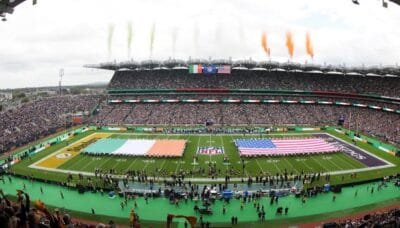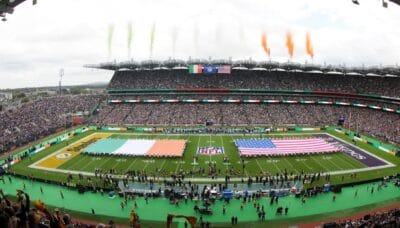
The Pittsburgh Steelers held on for a thrilling 24–21 win over the Minnesota Vikings as the NFL staged a historic game at Dublin’s Croke Park on Sunday. From my seat in the stands, the spectacle was dazzling. The music over the tannoy never stopped. Crowds were aldo constantly in full voice, even when play halted. Then when penalties were announced, doom-laden chords echoed through the stadium, prompting boos as loud as the cheers.
Dublin Hosts Historic NFL Game
The game itself appeared to me, a newcomer, as a carefully orchestrated dance. Players bounded on and off the field in choreographed bursts, a series of moving parts threatening at times to overwhelm the uninitiated. Yet their athleticism was undeniable: balletic, gymnastic, bouncing with effortless power. At one moment, a fan kicked a ball through the posts to win €25,000, a reminder that this is both entertainment and business.
More than 70,000 packed into Croke Park, the majority American fans. And as befitted a Steelers home game, there was more yellow than purple in the crowd, Pittsburgh’s colours claiming Dublin for the night.
It was officially a Steelers home game, but Dublin was the chosen venue. The Irish capital embraced the occasion, its fans adopting the chants, rhythms, and rituals of the American game with gusto.
Data Behind the Drama
For all the colour and spectacle, there is a deeper story shaping the NFL today: the marriage of sport and technology. At the centre is AWS, which since 2017 has been working with the league to bring artificial intelligence and machine learning to player health, safety, and performance.
Julie Souza, AWS’s Global Head of Sports, explained how the technology underpins everything from injury prevention to rule changes.
“We’re collecting about 500 million data points per week,” she told me. “Sensors in the shoulder pads, chips in the ball, optical tracking cameras, all that data flows into a digital athlete portal that every club can access. The aim is to detect players at risk of injury before it happens, so coaching and training staffs can intervene.”
In its first season alone, this approach reduced missed games by 700, simply because medical teams could adjust workloads before injuries struck. Souza calls it “math to your gut” not a replacement for instinct or coaching judgment, but an added tool. “It’s meant to be additive, not a cure-all,” she said. “Coaches will always know things data can’t capture. But the data proves, challenges, and refines those instincts.”
The data has reshaped the game itself. The kickoff rule, once notorious for concussions, was modelled in 10,000 simulated seasons. The league then introduced changes that reduced injuries to the level of a standard play while increasing returns, making it both safer and more exciting. Another example: the hip-drop tackle, which carried a 20-times higher injury risk, was banned after analysis of 20,000 plays confirmed its dangers.
Souza also noted the evolution of helmets: once uniform, now position-specific, tailored to absorb the impacts faced by quarterbacks differently from wide receivers. Tackle Probability, another AWS tool, uses machine learning to calculate in real time the likelihood of a defender making a stop. It has already altered the way teams assess both defensive reliability and offensive elusiveness.
Crucially, the system is permissioned. “All of this is collectively bargained with the players’ union,” Souza stressed. “Athletes agree what data is collected and how it’s used. Right now, we’re only gathering from pads, helmets, and the ball, not the player’s body itself. And the security of that data is paramount.”
The future, she hinted, may include mental health. “Supporting the whole athlete is now a league priority. I would imagine one day we’ll see that data integrated too, but only if players agree.”
Irish Roots, Irish Future
This first regular-season NFL game in Ireland was more than a novelty. The ties run deep. Back in the 1920s, one of the league’s formative presidents, Joseph Carr, was the American-born son of Irish immigrants. He professionalised the NFL, introduced divisions, and even encouraged the Rooney family to take ownership of what became the Pittsburgh Steelers.
Irish-born players have also left their mark. Bob Nash, from the Meath–Westmeath border, became the first captain of the New York Giants. In the 1970s, Dublin-born Neil O’Donoghue, a former Gaelic and soccer player, found a second career as an NFL kicker, becoming the league’s longest-serving Irish-born player. Today, Daniel Whelan from Enniskerry, County Wicklow, punts for the Green Bay Packers.
From West Cork to Croke Park
As the crowd roared and the spectacle unfolded, I found myself seated beside the team from the Irish NFL Show, enthusiasts who have turned their passion into a funded second job. One of them, Kieran O’Donovan, a teacher from West Cork, tried valiantly to explain the intricacies of play calls, substitutions, and strategy. I listened carefully, but much of it remained clear as mud. Except for one thing: the clock is everything.
And in Dublin, on this historic Sunday, time was on the side of the Steelers.
See more breaking stories here.
